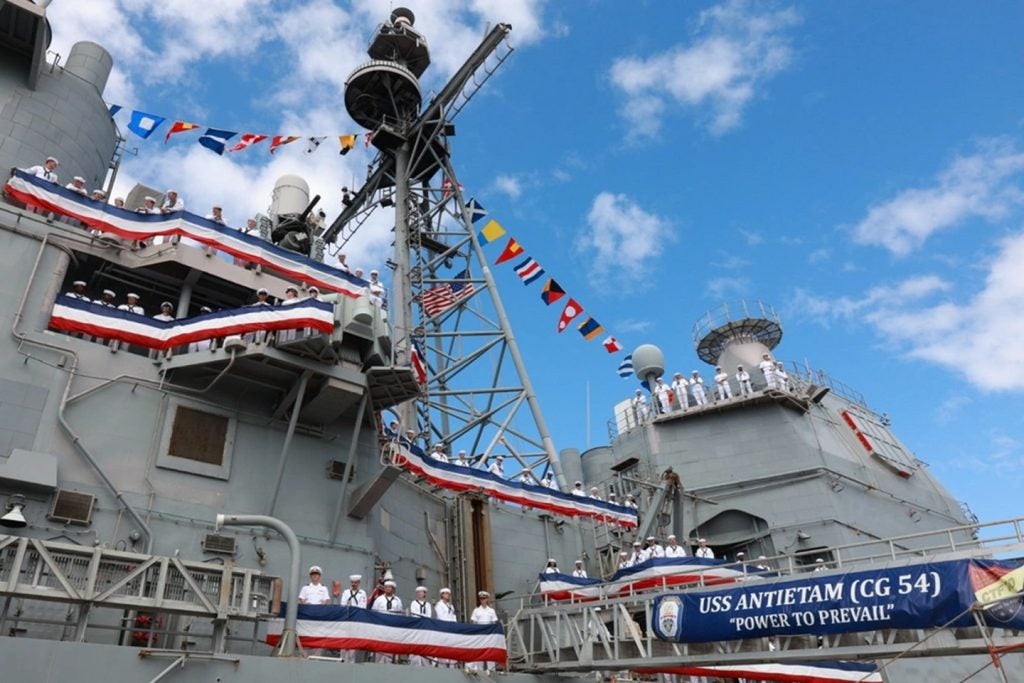
With the decommissioning of USS Antietam, the US Navy continues its modernisation strategy, balancing legacy asset retirements with fleet upheaval.
The US Navy decommissioned the USS Antietam (CG 54) on September 27, 2024, after 37 years of service.
The USS Cowpens (CG 63) and USS Leyte Gulf (CG 55), both Ticonderoga-class guided-missile cruisers, were decommissioned within the last month. The USS Cowpens was retired on August 28, 2024, after 33 years of service, and the USS Leyte Gulf was decommissioned on September 20, 2024, after 37 years.
The retirement of the USS Antietam, a Ticonderoga-class guided-missile cruiser, is part of the Navy’s efforts to phase out ageing vessels and invest in modern platforms that offer greater technology.
Impact on the naval defence industry
Despite their decades-long roles, Ticonderoga-class cruisers represent outdated technology compared to newer classes of ships like the Zumwalt-class destroyers and the forthcoming Constellation-class frigates.
The Ticonderoga-class was acquired between 1983 and 1994. GlobalData’s intelligence on the US defence market highlights that the DDG (X) programme, at least in its initial stages, calls for a plan to replace 22 Ticonderoga-class destroyers.
Defence contractors, including BAE Systems, General Dynamics, and Huntington Ingalls Industries, are positioned to benefit from these transitions. The US Navy’s push to retire 11 Ticonderoga-class cruisers by 2027 translates into opportunities for modernisation projects.
Other US Naval modernisation milestones occurred last week, HII’s Ingalls Shipbuilding division secured a $9.6bn deal to construct four new amphibious ships for the US Navy, including three San Antonio-class Flight II (LPD 17) vessels and one America-class (LHA 6) large-deck amphibious ship.
A case for supply chain evolution
In addition to shipbuilders, suppliers of materials and components—ranging from propulsion systems to combat systems—must adapt to the changing landscape. As the Navy shifts focus from heavy, armoured ships to faster, more versatile vessels, the demand for materials like composite metals, lightweight alloys, and stealth technologies is expected to rise.
This is relevant for companies like Raytheon Technologies, which provides missile and radar systems essential to the next generation of naval vessels. Raytheon’s SPY-6 radar, for example, is designed for missile detection and is being integrated into the Navy’s Flight III Arleigh Burke-class destroyers, set to replace some of the ageing Ticonderoga-class cruisers.
Balancing cost and fleet size
The Navy’s modernisation efforts are subject to controversy. Concerns exist about the pace of decommissioning and its impact on fleet readiness. Retiring so many cruisers quickly could temporarily reduce the Navy’s overall combat capability, leaving gaps in sea power, particularly in the Pacific theatre where tensions with China are rising.
However, Cmdr. Victor J. Garza, the final commanding officer of the USS Antietam, emphasised during the decommissioning ceremony, “The soul of Antietam is in her Sailors… We bring the heartless steel and iron to life. Today, we lay her to rest, but we keep the soul.” His words reflect a sentiment that while the ship may be gone, the focus is on ensuring the Navy’s future force remains.
Rear Adm. Christopher Moe (USN, Ret.), a former commander of the Antietam, spoke to the importance of this ship: “I was there June 6, 1987, when USS Antietam was commissioned in Baltimore, Maryland. The ceremony was a magnificent start to 37 years of service that will end today after thousands of young men and women crossed her quarterdeck, anxious to serve this great nation”.

The Navy’s ongoing pursuit of unmanned surface vessels (USVs), increased reliance on digital shipbuilding, and integration of autonomous technologies into naval warfare systems all represent areas for investment.
The decommissioning of the USS Antietam is a move that emphasises the US Navy’s modernisation goals.




